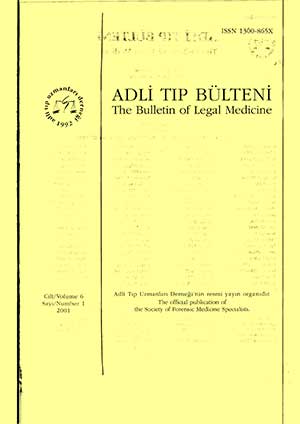Abstract
The purpose of this study is to make a contribution to the formation of a database regarding the identification from the skeletal bones spesific to the Turkish Community. The skeletal bones sent to the State Institute of Forensic Medicine were used for this purpose. Measurements consistent with the international standards were obtained from femur, tibia, fibula, humerus, radius and ulna. Statistically significant differences were found between all upper extremity bone mesaurements with maximum length of the femur, bicondylar length of the femur, epicondylar breadth of the femur, length of the tibia, maximum epiphyseal breadth of the proximal tibia, A-P breadth of the corpus tibia, circumference of the tibia at the nutrient foramen and length of the fibula that belongs to lower extremity with respect to sex (Student’s t-test p<0,05-p<0,001). The data obtained were compared with relevant scientific literature with a similar content.
Key Words: Forensic anthropology, Turkish community, femur, tibia, fibula, humerus, ulna, radius.
References
Boldsen JL. Body Proportions, population structure and height prediction. Adli Tıp Dergisi, 1990; 6:157- 165.
Allbrook D. The estimation of stature in british and east african males. Based on tibial and ulnar bone lengths. J Forens Med. 1961; 8:15-28.
Buikstra JE, Ubelaker DH. Standards for data collection from human skeletal remains, Arkansas Archaeological Survey, Arkansas, 1994;80-84.
Jansen MMP, Ousley SD, Jantz RL. Data collection procedures for forensic skeletal material, Third Ed., The University of Tennessee Forensic Antropology Series, 1994: 63-71.
Günay Y. Tibia uzunluğundan boy uzunluğunun hesaplanması, Uzmanlık Tezi, İstanbul, 1995: 5-13-
Güleç ES, İşcan MY. Forensic antropology in Turkey, Forensic Science International, 1994; 66:61-8.
Wurm H. Zur Geschichte der körperhöhenschatzung nach skeletfunden (Körperhöhenschatzungen für Manner) Die vorgeschlagenen Ansätze zur Körperhöhenschatzung nach Skeletfunden seit der Mitte des 20, Jahrhunderts, Gegenbaurs Morph, Jahrb., Leipzing, 1985; 131(3): 383-432.
Jantz RL. Modification of the Trotter and Gleser female stature estimation formulae, Journal of Forensic Sciences, 1992; 37(5): 1230-1235.
Özer İ, Sağır M, Sevim A, Güleç E. İki Ortaçağ toplumunda cinsiyet kriterlerinin istatistiksel ve morfolojik açıdan incelenmesi, 14-17 Nisan 1998, III. Adli Bilimler Kongresi, Kuşadası, S. 18.
Özer İ. Dilkaya. (Van) populasyonunun diskriminant fonksiyon analizi ve Anadolu toplulukları arasındaki yeri, 1999; A.Ü. Sosyal Bilimler Enstitüsü Fizik ve Paleoantropoloji Anabilim Dalı Doktora Tezi, Ankara.
Ziylan T, Yücel N, Murshid K, Uysal İ. Orta Anadolu’da son yüz yıllarda yaşamış insan femurlarının antropometrik analizi ve kalkolitik çağda yaşayanların femurları ile karşılaştırılması, 25- 26 Ekim 2000, II. Ulusal Biyolojik Antropolojik Sempozyumu, Ankara, S.13.
Simmons TMA, Jantz RL, Bass WM. Stature estimation from fragmentary femora: A revision of the Steele method. Journal of Forensic Sciences, 1990; May: 628-36.
Mysorekar VR, Nandedkar AN, Sarma TCSR. Estimation of stature from parts of ulna and tibia, Med Sei Law, 1984; 24 (2): 113-5.
Holman DJ, Bennett KA. Determination of sex from bone measurements, American Journal of Physical Anthropology, 1991; 84: 421-6.
The Journal and content of this website is licensed under the terms of the Creative Commons Attribution (CC BY) License. The Creative Commons Attribution License (CC BY) allows users to copy, distribute and transmit an article, adapt the article and make commercial use of the article. The CC BY license permits commercial and non-commercial re-use of an open access article, as long as the author is properly attributed.
